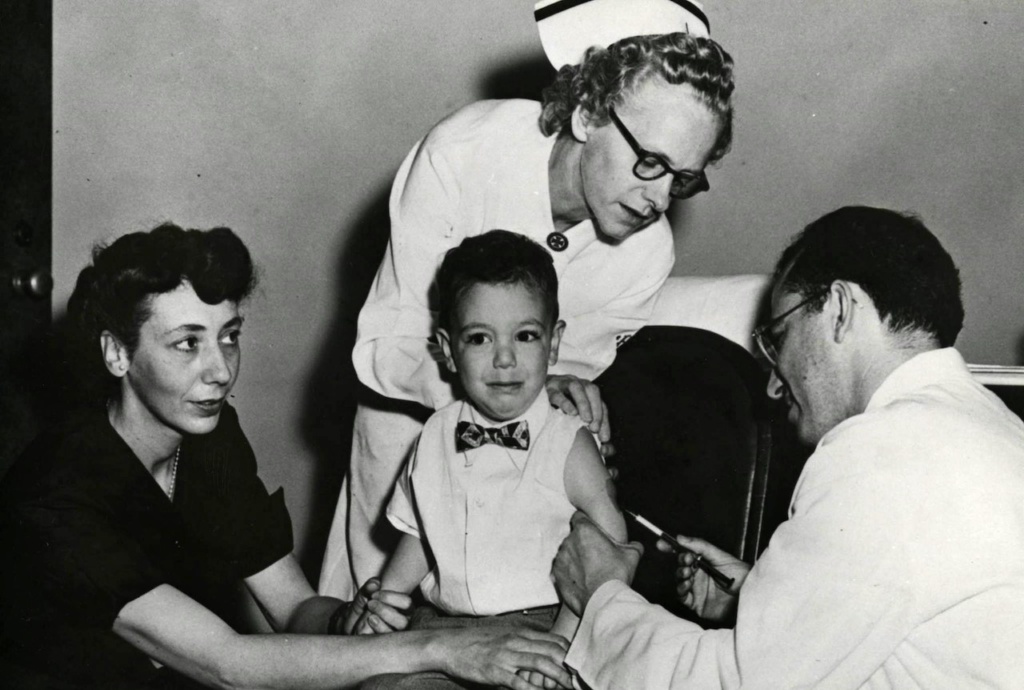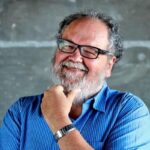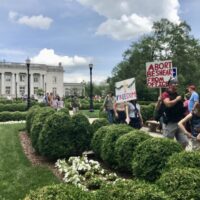A hornet stung me in the neck when I was 4. I was playing in Pop Paw’s carport in the skinny passage between his DeSoto and the wall. By the time I got to the kitchen window to tell my mom and granny something was already going on. They ran out to me. Mom said I swoll-up double. They walked me to the Hazard Clinic, maybe two football fields away, and I went into a coma. I can not tell you a lot about being in a coma, just that maybe I saw some things I wasn’t supposed to.
- SUBSCRIBE: Sign up for Hoptown Chronicle’s newsletters
My other granny was convinced that I had not been looked after well that day and often told the story: “You were so lucky. Just that week Dr. Boggs had gotten in a miracle drug, and he gave you a shot, and he saved your life.”

(Photo from UC San Diego Library, Mandeville Special Collections)
What began then was a childhood of visits to Dr. Boggs and more specifically to his nurse Nola to get allergy shots. At first with my mom, and then on my own. You would get your file downstairs at the clinic check-in, ride up the elevator pushing all the buttons, knock on the doctor’s door to hand over the file, then wait — what seemed like hours — until Nola would step out and say, “Come over here, baby, let me stick you.”
The waiting room was full of people sicker than me: crippled up miners, slow-moving grannies, kids who you knew were dirt poor. There were these stand-up ash trays, and the smell of Pall Malls and Prince Albert rolled from the can. The clinic walls were decorated with March of Dimes posters all with pictures of smiling kids in leg braces from catching polio. Dr. Boggs had a framed picture on his office wall of a man in an iron lung. And I remember one day a little tiny woman, maybe in her 40s, or 50, sat in the waiting room weeping inconsolably from the time I got out of the elevator until the hour I left. She held this dissolving wad of Kleenex, tears puddling on the tile by her foot. We all sat there, the adults trying not to stare. Even a kid figures out that you get your most unbearable news from doctors. And always after my shot, Nola would give me a Saf-T-Pop sucker, of which grape was the best and most sought after.
For people who did not live through the polio era, it was a time of explicit fear. Everyone knew FDR had been a victim, and everyone knew victims. Kids in a leg brace at your school, adults in wheel chairs, gimpy strangers on the street. You tried not to stare. Every March we carried home cardboard folders from school with slots for nickels and dimes. The TV would tell you to be generous when the March of Dimes volunteer knocked on your door. Old people still called it the Mothers March, because that was what it was when Roosevelt was alive, mothers versus the sickness.
Polio was our scourge. A crippling, killing virus that could put a strong man in an iron lung or take a child. And the nation’s response, the world’s response, was a lot like we’ve heard our governor in Kentucky say most days at 5 o’clock, “We will get through this together.” The prayer of an underdog.
I met Jonas Salk, the doctor from the University of Pittsburgh who took the dimes and created the vaccine that saved the world. In the 1990s I was invited to address the board of the John D. and Catherine T. MacArthur Foundation. The speakers were me, Thomas Freebairn, and Bill Moyers. Freebairn, a television historian, showed them how much video had shrunk from the early days of giant two-inch reels to the little cameras the Reuters reporters were carrying (Not sure how that helped). Moyers had just done a PBS special on poetry written by seventh graders, and his presentation was to read as many of those poems as his time would allow (First thing to know is that seventh graders can’t write poetry, and second thing is that reading a lot of it does not make the time go better).
For my presentation I made the case that an emerging generation of media artists were seeking a just world that went beyond a Newtonian existence on a Euclidian plane, that we sought more than societal maintenance, more than actions causing equal and opposite reactions, that we were out to create catalytic quantum transformational change. I had cribbed a lot of it from a little book I accidentally came across in the University of Pittsburgh library. It was a lecture from the Russian president of the Einstein Society, but instead of media artists, he said Dostoevsky was seeking to go beyond Newton in the last chapter of Brothers Karamazov. Pretty much same same. All I knew was on that day in Chicago at the Drake Hotel I was killing it. I was funny, inspiring, I talked with my hands.
Surprisingly after it was over the luminaries on the foundation board — among them a steel magnate, a former U.S. secretary of Education, head of an insurance company, a bank president — all went over to talk to Moyers. The one guy who did come up to me was Murray Gell Mann, the Nobel laureate in physics. He said he enjoyed my talk, but he was having a little difficulty following the quantum. (Sadly, that was neither the time nor the place to break down my theory of social fission for him).
Then this lanky guy in his 80s, long white hair in a duck tail, walked over from the other side of the room. “Hi, I am Jonas Salk, and I just want to say what you are doing is marvelous. What you are doing is you are creating a vaccine for society.” Just then my buddy, (and now my witness,) Tom Weinberg walked up. I introduced him to Dr. Salk, and again he said, “What you young men are doing is creating a vaccine for society.” And he put his hands on our shoulders.
We all do our best, try to walk in the shadows of helpers like nurse Nola, Dr. Boggs, Fyodor Dostoevsky, and pray there is a miracle drug in the fridge on the day we swell up. Let’s get through this thing.
(Dee Davis is president of the Center for Rural Strategies, which publishes the Daily Yonder.)
Dee Davis is president of the Center for Rural Strategies and publisher of The Daily Yonder, a nonprofit newsroom that provides news, commentary and analysis about and for rural America. It is the news platform for the Center for Rural Strategies, which has offices in Whitesburg, Kentucky, and Knoxville, Tennessee. Davis is on twitter @iamflyrock.






